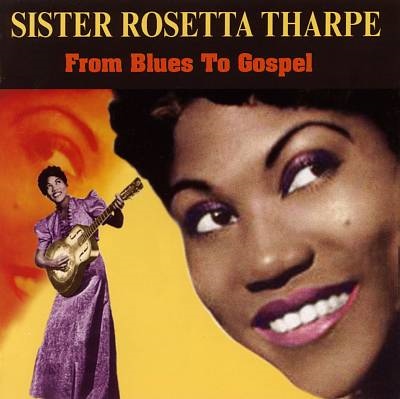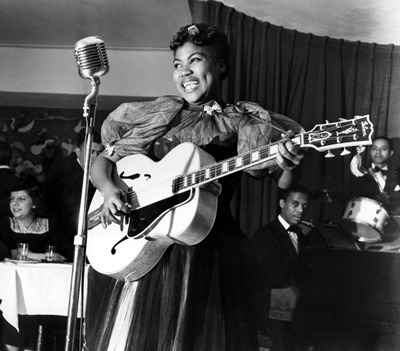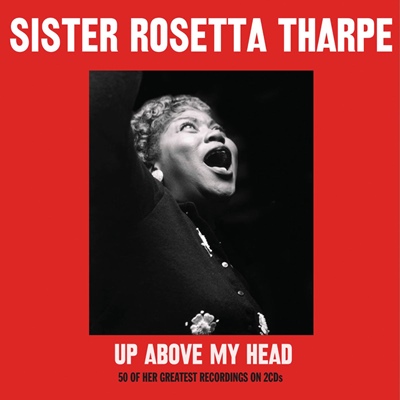

Spotlight on The King #1: How Sister Rosetta Tharpe Influenced Elvis' Music On a regular basis EIN examines a new release or issue in the Elvis
world. In this edition we shine our spotlight on: On a regular basis EIN examines a new release or issue in the Elvis
world. In this edition we shine our spotlight on:
Influences On A Legend – Sister Rosetta Tharpe The southern states of America are a melting pot of fiercely emotive musical genres from the raw blues belters on Beale Street and in New Orleans to energetic black spirituals and white gospel songs and the pure country and western sounds of Nashville. In the 1940s and 1950s these influences would help shape the musical style of the future King of Rock ‘n’ Roll, Elvis Aaron Presley. While white gospel singers influenced Elvis’s ballad style, black spiritual singers were a major influence on his rock and roll style replete with movements. One of those seminal black influences on the young Elvis was Sister Rosetta Tharpe. Each day Elvis would rush home from school in Tupelo to listen to her and other singers on WELO’s daily half hour of black gospel. According to his school friend, Billy Welch, Elvis would never miss a show. The influence was undoubtedly fueled by Elvis’s parents with their strong religious beliefs. By the time he was 9 years old, Elvis, Gladys and Vernon were a popular singing trio, appearing at local churches and revivals. Their delivery of what was known as country gospel had to have been of seminal importance to the young Elvis in fashioning his own unique musical style. As a clue to the musical personality that was Rosetta Tharpe, Ken Romanowski described her as "Flamboyant, histrionic, magnetic and precocious...". Rosetta Tharpe and Elvis shared a lot in common. Both were musical innovators who combined diverse musical genres to form a hybrid sound. In the case of Sister Tharpe she blended ballsy, black spirituals with white big band jazz. In Elvis’ case, he blended white country and gospel with black rhythm and blues.
Moreover, Rosetta Tharpe angered her church leaders by "putting too much motion as well as emotion into her singing", a criticism later to be widely and loudly voiced at Elvis the Pelvis. While the young Elvis could not have fully appreciated Tharpe’s stage presence and movements from listening to the radio, the raw, ecstatic emotion of Tharpe’s voice undoubtedly left its mark.
In his excellent book ‘The Gospel Sound’, music historian Anthony Heilbut notes that Tharpe demonstrated the connections among all black musical forms by shifting from sacred to profane with a mere change in lyrics. In a not too dissimilar way to Elvis giving 1950s youth their own musical form, Rosetta Tharpe brought her brand of blended black gospel music to a mass audience and critical acclaim on Broadway singing with Cab Calloway and his Orchestra and Lucky Millander’s band at venues such as The Cotton Club. She was an integral part of the historic Spirituals To Swing concert at Carnegie Hall in December 1938. For the first time black gospel was brought to a white audience. Like Elvis, her music knew no boundaries and she perfected her own style of bending notes and phrasing words. She entered the stage with brightly dyed flame-red hair and her guitar slung over her shoulder. Her typical pose was standing guitar in hand not unlike Elvis would do in the 1950s. Rosetta’s different versions of the same song could range from big band accompaniment to boogie woogie, country style or a church choir backing. As a child Rosetta accompanied her mother, travelling evangelist Katie Bell Nubin, and was described as tearing up the churches with songs such as I Looked Down The Line and God Don’t Like It. By the age of six she had mastered the guitar. Later, as one of forerunners of soul music’s ‘earth mamas’ (the big, statuesque black women with big, belting contralto voices such as Mahalia Jackson and Etta James) Rosetta tore up the clubs and churches often reducing her audience and congregation "to an emotional pulp". Rosetta Tharpe’s records rose high on the race charts in America and influenced not only Elvis but other rockers including Jerry Lee Lewis and his hybrid of hillbilly, blues and gospel. As a recording artist she shocked her more pious black listeners with songs such as I Want A Tall Skinny Papa and delighted white listeners with Rock Me and This Train. Parallels can be drawn with Elvis physically and lyrically suggestive rendition of songs such as Shake, Rattle and Roll (in which he essentially used Big Joe Turner’s version rather than the softer lyric version sung by Bill Haley and the Comets), his rocking delivery of Jailhouse Rock and his mainstream ‘balladeering’ style on Love Me Tender. Her fame resulted in a 1939 feature article by LIFE magazine in which she was described as "moving the saints on Sunday and entertaining the big spenders on Monday". Tharpe was also an impressive entrepreneur - her 1951 wedding (her third marriage) to her manager Russell Morrison was an event attended by 25,000 paying guests. "The wedding culminated in a $5,000 fireworks display including a 20 foot representation of her with her guitar". In 1944 Rosetta recorded the first of several sessions with pianist Sam Price. As noted by Ken Romanowski, Price’s combo was a rhythm and blues band of the type which would soon replace the costly big bands. Not surprisingly, the Price recordings put Rosetta once again "at the cutting edge of popular black music". Elvis was to record several songs sung by Tharpe. The most notable of these were Up Above My Head, Just A Closer Walk With Thee (This Train) = 'My Babe' and Down By The Riverside. In the 1950s Rosetta Tharpe’s star began to wane and in her place Mahalia Jackson assumed the position as gospels biggest star. Following a stroke, Sister Rosetta Tharpe died on October 9, 1973 at the age of 58. The headstone erected on her grave decades after her death bears these words: “She would sing until you cried, and then she would sing until you danced for joy. She kept the church alive and the saints rejoicing.” - and more importantly she helped influence the young Elvis Presley - and so helped create the sound of rock’n’roll.
Sister Rosetta Tharpe’s musical legacy is substantially preserved on CD with numerous albums available. Her best works (although admittedly missing Up Above My Head) are arguably available on the 2 volume retrospective Sister Rosetta Tharpe Complete Recorded Works 1938 – 1941 and Sister Rosetta Tharpe Complete Recorded Works 1942 –1944, released by Document Records (catalogue numbers DOCD-5334 and DOCD-5335 respectively). Both albums contain detailed liner notes and biography.
Acknowledgements: Elaine Dundy, Elvis and Gladys Anthony Geilbut, The Gospel Sound Ken Romanowski, Liner Notes to Sister Rosetta Tharpe Complete Recorded Works 1938-1944 Peter Whitmer, The Inner Elvis Barney Hoskins, From A Whisper To A Scream This
article was written by Nigel Patterson and first appeared in ‘Elvis
Monthly’ as part of the author’s fourteen part series, Influences
On A Legend. ©1998, 2002 Click to comment on this article
|


